2009 CHEVROLET AVALANCHE tow
[x] Cancel search: towPage 1 of 550

Seats and Restraint System............................. 1-1
Head Restraints
......................................... 1-2
Front Seats
............................................... 1-3
Rear Seats
..............................................1-13
Safety Belts
.............................................1-15
Child Restraints
.......................................1-37
Airbag System
.........................................1-62
Restraint System Check
............................1-78
Features and Controls..................................... 2-1
Keys
........................................................ 2-3
Doors and Locks
......................................2-10
Windows
.................................................2-25
Theft-Deterrent Systems
............................2-28
Starting and Operating Your Vehicle
...........2-32
Mirrors
....................................................2-55
Object Detection Systems
..........................2-58
OnStar
®System
......................................2-66
Universal Home Remote System
................2-69
Storage Areas
.........................................2-76
Sunroof
..................................................2-93Instrument Panel............................................. 3-1
Instrument Panel Overview
.......................... 3-4
Climate Controls
......................................3-20
Warning Lights, Gages, and Indicators
........3-29
Driver Information Center (DIC)
..................3-46
Audio System(s)
.......................................3-76
Driving Your Vehicle....................................... 4-1
Your Driving, the Road, and the Vehicle
....... 4-2
Towing
...................................................4-40
Service and Appearance Care.......................... 5-1
Service
..................................................... 5-3
Fuel
......................................................... 5-5
Checking Things Under the Hood
...............5-12
Rear Axle
...............................................5-45
Four-Wheel Drive
.....................................5-46
Front Axle
...............................................5-47
Headlamp Aiming
.....................................5-48
Bulb Replacement
....................................5-51
Windshield Wiper Blade Replacement
.........5-54
Tires
......................................................5-55
2009 Chevrolet Avalanche Owner ManualM
Page 5 of 550

Vehicle Symbol Chart
Here are some additional symbols that may be found on
the vehicle and what they mean. For more information
on the symbol, refer to the index.
0:Adjustable Pedals
9:Airbag Readiness Light
#:Air Conditioning
!:Antilock Brake System (ABS)
g:Audio Steering Wheel Controls or OnStar®
$:Brake System Warning Light
":Charging System
I:Cruise Control
B:Engine Coolant Temperature
O:Exterior Lamps
#:Fog Lamps
.:Fuel Gage
+:Fuses
i:Headlamp High/Low-Beam Changer
j:LATCH System Child Restraints
*:Malfunction Indicator Lamp
::Oil Pressure
g:Outside Power Foldaway Mirrors
}:Power
/:Remote Vehicle Start
>:Safety Belt Reminders
7:Tire Pressure Monitor
_:Tow/Haul Mode
F:Traction Control
M:Windshield Washer Fluid
v
Page 19 of 550
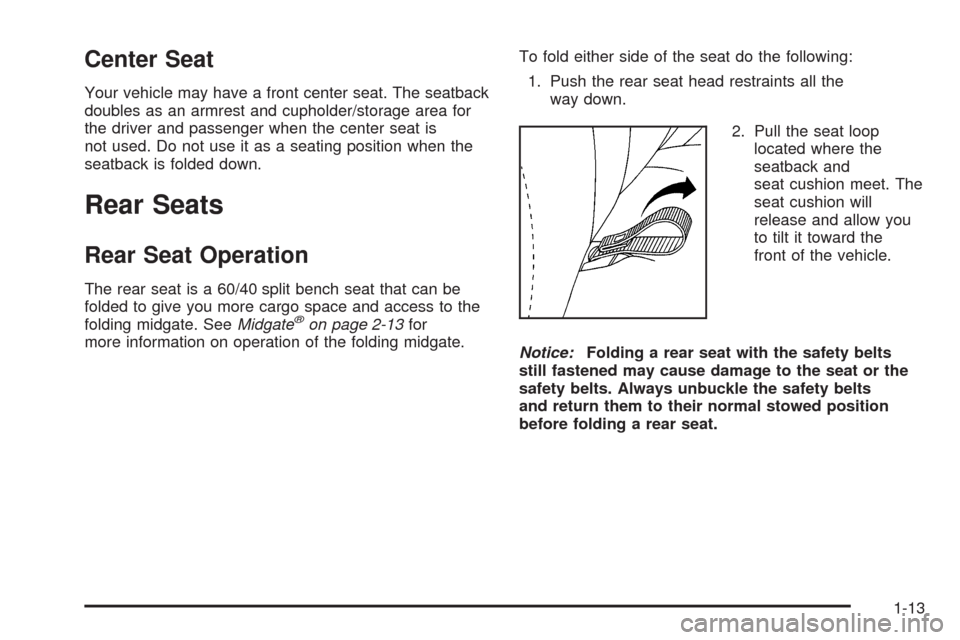
Center Seat
Your vehicle may have a front center seat. The seatback
doubles as an armrest and cupholder/storage area for
the driver and passenger when the center seat is
not used. Do not use it as a seating position when the
seatback is folded down.
Rear Seats
Rear Seat Operation
The rear seat is a 60/40 split bench seat that can be
folded to give you more cargo space and access to the
folding midgate. SeeMidgate
®on page 2-13for
more information on operation of the folding midgate.To fold either side of the seat do the following:
1. Push the rear seat head restraints all the
way down.
2. Pull the seat loop
located where the
seatback and
seat cushion meet. The
seat cushion will
release and allow you
to tilt it toward the
front of the vehicle.
Notice:Folding a rear seat with the safety belts
still fastened may cause damage to the seat or the
safety belts. Always unbuckle the safety belts
and return them to their normal stowed position
before folding a rear seat.
1-13
Page 36 of 550
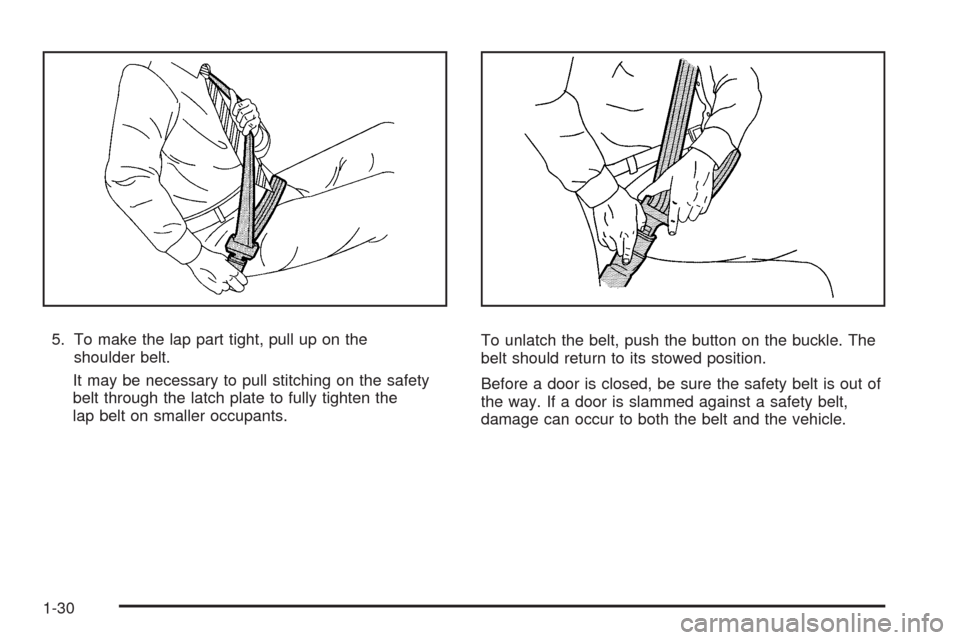
5. To make the lap part tight, pull up on the
shoulder belt.
It may be necessary to pull stitching on the safety
belt through the latch plate to fully tighten the
lap belt on smaller occupants.To unlatch the belt, push the button on the buckle. The
belt should return to its stowed position.
Before a door is closed, be sure the safety belt is out of
the way. If a door is slammed against a safety belt,
damage can occur to both the belt and the vehicle.
1-30
Page 59 of 550

{CAUTION:
Do not attach more than one child restraint to a
single anchor. Attaching more than one child
restraint to a single anchor could cause the anchor
or attachment to come loose or even break during
a crash. A child or others could be injured. To
reduce the risk of serious or fatal injuries during a
crash, attach only one child restraint per anchor.
{CAUTION:
Children can be seriously injured or strangled if a
shoulder belt is wrapped around their neck and
the safety belt continues to tighten. Buckle any
unused safety belts behind the child restraint so
children cannot reach them. Pull the shoulder belt
all the way out of the retractor to set the lock, if
your vehicle has one, after the child restraint has
been installed.Notice:Do not let the LATCH attachments rub
against the vehicle’s safety belts. This may damage
these parts. If necessary, move buckled safety
belts to avoid rubbing the LATCH attachments.
Do not fold the empty rear seat with a safety belt
buckled. This could damage the safety belt or
the seat. Unbuckle and return the safety belt to its
stowed position, before folding the seat.
1. If the child restraint manufacturer recommends that
the top tether be attached, attach the top tether to
the top tether anchor, if there is one. Refer to
the child restraint instructions and the following
steps:
1.1. To access the top tether anchors, raise the
seat cushion by pulling up on the strap loop
at the rear of the seat cushion and fold
the seat cushion forward. Then fold
the seatback forward until it is �at. SeeRear
Seat Operation on page 1-13for additional
information.
1.2. Place the child restraint in the vehicle, near
the seating position that you are using.
1-53
Page 64 of 550
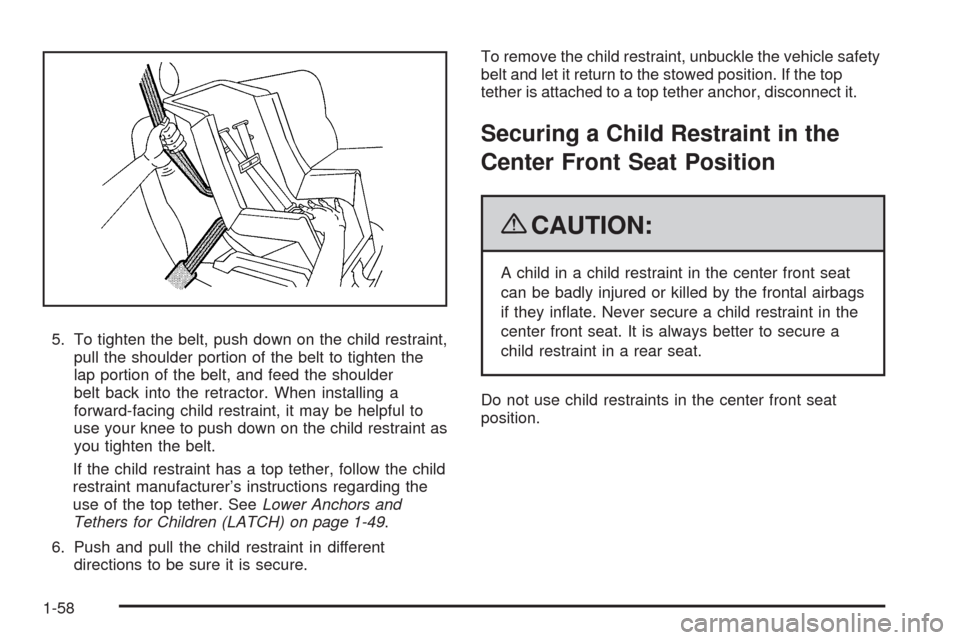
5. To tighten the belt, push down on the child restraint,
pull the shoulder portion of the belt to tighten the
lap portion of the belt, and feed the shoulder
belt back into the retractor. When installing a
forward-facing child restraint, it may be helpful to
use your knee to push down on the child restraint as
you tighten the belt.
If the child restraint has a top tether, follow the child
restraint manufacturer’s instructions regarding the
use of the top tether. SeeLower Anchors and
Tethers for Children (LATCH) on page 1-49.
6. Push and pull the child restraint in different
directions to be sure it is secure.To remove the child restraint, unbuckle the vehicle safety
belt and let it return to the stowed position. If the top
tether is attached to a top tether anchor, disconnect it.
Securing a Child Restraint in the
Center Front Seat Position
{CAUTION:
A child in a child restraint in the center front seat
can be badly injured or killed by the frontal airbags
if they in�ate. Never secure a child restraint in the
center front seat. It is always better to secure a
child restraint in a rear seat.
Do not use child restraints in the center front seat
position.
1-58
Page 68 of 550
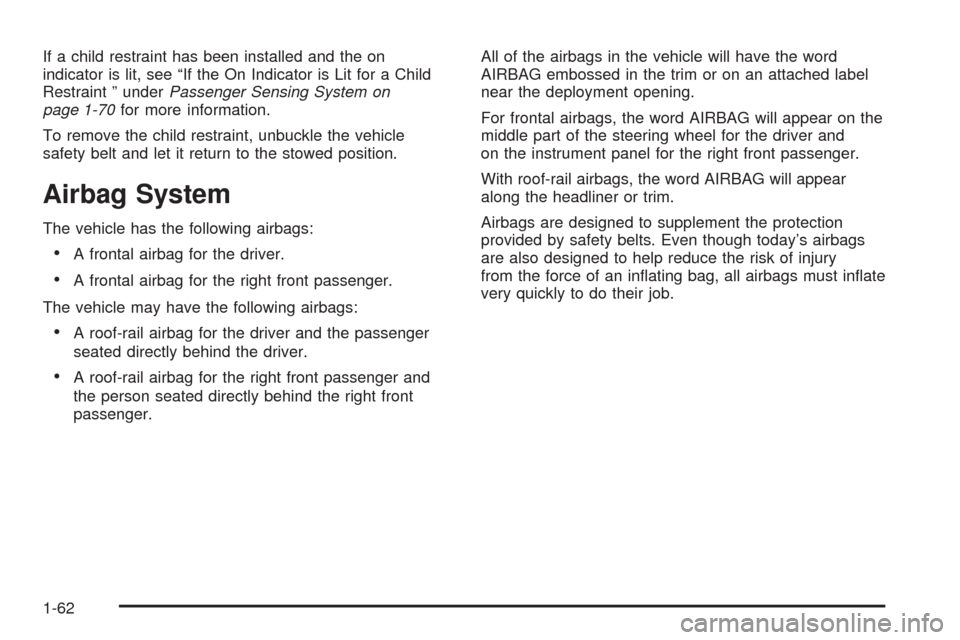
If a child restraint has been installed and the on
indicator is lit, see “If the On Indicator is Lit for a Child
Restraint ” underPassenger Sensing System on
page 1-70for more information.
To remove the child restraint, unbuckle the vehicle
safety belt and let it return to the stowed position.
Airbag System
The vehicle has the following airbags:
A frontal airbag for the driver.
A frontal airbag for the right front passenger.
The vehicle may have the following airbags:
A roof-rail airbag for the driver and the passenger
seated directly behind the driver.
A roof-rail airbag for the right front passenger and
the person seated directly behind the right front
passenger.All of the airbags in the vehicle will have the word
AIRBAG embossed in the trim or on an attached label
near the deployment opening.
For frontal airbags, the word AIRBAG will appear on the
middle part of the steering wheel for the driver and
on the instrument panel for the right front passenger.
With roof-rail airbags, the word AIRBAG will appear
along the headliner or trim.
Airbags are designed to supplement the protection
provided by safety belts. Even though today’s airbags
are also designed to help reduce the risk of injury
from the force of an in�ating bag, all airbags must in�ate
very quickly to do their job.
1-62
Page 75 of 550
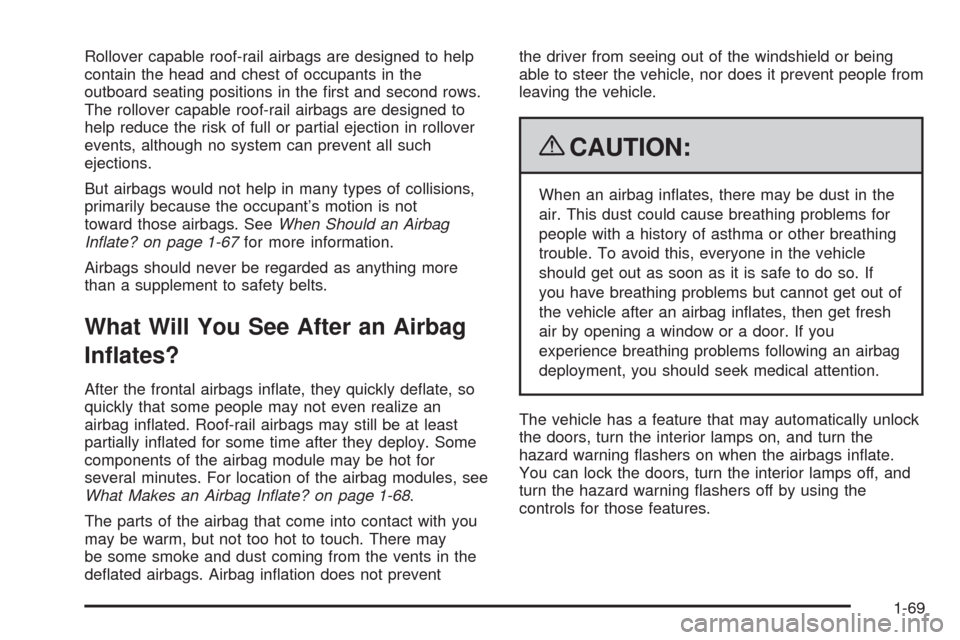
Rollover capable roof-rail airbags are designed to help
contain the head and chest of occupants in the
outboard seating positions in the �rst and second rows.
The rollover capable roof-rail airbags are designed to
help reduce the risk of full or partial ejection in rollover
events, although no system can prevent all such
ejections.
But airbags would not help in many types of collisions,
primarily because the occupant’s motion is not
toward those airbags. SeeWhen Should an Airbag
In�ate? on page 1-67for more information.
Airbags should never be regarded as anything more
than a supplement to safety belts.
What Will You See After an Airbag
In�ates?
After the frontal airbags in�ate, they quickly de�ate, so
quickly that some people may not even realize an
airbag in�ated. Roof-rail airbags may still be at least
partially in�ated for some time after they deploy. Some
components of the airbag module may be hot for
several minutes. For location of the airbag modules, see
What Makes an Airbag In�ate? on page 1-68.
The parts of the airbag that come into contact with you
may be warm, but not too hot to touch. There may
be some smoke and dust coming from the vents in the
de�ated airbags. Airbag in�ation does not preventthe driver from seeing out of the windshield or being
able to steer the vehicle, nor does it prevent people from
leaving the vehicle.
{CAUTION:
When an airbag in�ates, there may be dust in the
air. This dust could cause breathing problems for
people with a history of asthma or other breathing
trouble. To avoid this, everyone in the vehicle
should get out as soon as it is safe to do so. If
you have breathing problems but cannot get out of
the vehicle after an airbag in�ates, then get fresh
air by opening a window or a door. If you
experience breathing problems following an airbag
deployment, you should seek medical attention.
The vehicle has a feature that may automatically unlock
the doors, turn the interior lamps on, and turn the
hazard warning �ashers on when the airbags in�ate.
You can lock the doors, turn the interior lamps off, and
turn the hazard warning �ashers off by using the
controls for those features.
1-69